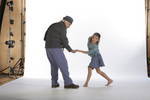- Telemachus Clay and Julia Milani
- Herb Heinz and Julia Milani
- Mana Hayakawa, Julia Milani, and Telemachus Clay
all photos are by Matt Haber
Peace About Life; Dancing with Parkinson’s
danceNAGANUMA
www.dancenaganuma.com
A few weeks ago I enjoyed the privilege of visiting San Francisco’s CounterPulse Theater for DanceNaganuma’s Peace About Life show. Performers of all ages, including very young children and older adults with Parkinson’s disease, moved about the stage. Sometimes soaring and gliding like ballerinas, and other times marching, brushing each other off, and conveying tension through more rigid postures, the dancers illustrated the different moods and aspects of the lives of those living with Parkinson’s disease.
Anecdotes about life post-diagnosis served as a background for some of the dancing: one woman resolved to push her body as far as possible through exercise rather than resign herself to helplessness, another man made peace with the wavy lines in his paintings after losing some control of his hands. Yet, the presence of people of all ages, with and without the disease, and the reliance on universal themes of interdependence, family relations, coping with aging and life transitions, rather than on specific medical details, made this dance performance a piece on the stages of life, relevant for many people outside the Parkinson’s community.
Some medical research at the University of Colorado-Denver currently looks into possible health benefits for Parkinson’s patients who dance or engage in other forms of exercise. Dance may actually prove especially beneficial as it encourages practice in the accurate, mindful motions which the condition tends to make difficult.
However, DanceNaganuma’s performance exists as much for the audience as for the cast and crew. This is not a physical therapy session, but a presentation of complex emotions and life’s confusion (in particular, a standout piece where dozens of young voices and bodies surround a few performers, all simultaneously chanting different ideas on what is most important in life.) This piece created the visceral effect in me which the choreographer hoped to convey: I had to restrain myself from jumping up and screaming for everyone to be quiet! In another scene, which earned my nods of recognition, many different people surrounded a single young healthy woman, attempting to pose her, make her smile, make her look presentable, and she fell out of line each time. Those with Parkinson’s themselves are not the only ones affected by the condition, or by aging in general – and I appreciated the attention paid to the effects on family and friends.
Not every piece seemed jerky and confused: some, especially the opening segment with dancers in flowing orange robes, reflected the grace and beauty still present within the participants’ movements. This gave dignity to all of the dancers – by allowing them to show off the best they could do in whatever condition life had brought them, rather than having them convey imposed ideas of ‘weakness’ or ‘age.’
Overall, Dance Naganuma’s Peace About Life: Dancing with Parkinson’s excels at living up to all the aspects of its name. The cast strikes a balance between illustrating life with a serious movement disorder and presenting their company’s skill at creating beautiful movements and stage pictures. Through conveying the disease’s effects through nontraditional methods (spoken word anecdotes, abstract renderings of emotion) and through the mix of ages and ethnicities present on stage, the company communicates a real sense of peace about life: that although one’s looks and ability to move will change with one’s age and health conditions, there is still a place where all people are welcome to come out and participate in public, where we do not have to camouflage or ignore reality to find and present the beauty of the human body, of movement and life in all its forms.
About Claudine Naganuma, the company’s founder:
Claudine Naganuma founded danceNAGANUMA in 2001. She has served as the Managing Director of Danspace since 2002 where she teaches modern dance, ballet and composition. Her company danceNAGANUMA is in residence at Danspace and has been producing work and performing in festival settings annually. She was selected as a Yerba Buena Center for the Arts Hong Kong/San Francisco exchange artist in 1999. She also received a Jack Loftis and Vibeke Strand Honorary Fellowship while at the Djerassi Artist in Residence Program. Her costume designs merited an Alexander Gerbode Foundation Award as well as two Isadora Duncan nominations for costumes in 1995 and 1992. She received her M.F.A. in Choreography and Performance from Mills College and her B.A. in English Literature from Dominican College. She studied Early Childhood Education at the Mills College Children’s School and continues to teach specialty classes at Aurora Elementary School and St. Paul’s Episcopal Schools in the East Bay. Claudine served as the Artistic Director of Asian American Dance Performances from 1992 to 2004 taking it into its 32nd anniversary.



